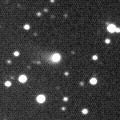
|
Although it was faint as 16.4 mag at the discovery in March (Mar. 12, R. H. McNaught), then it brightened well as expected, and now it is 11.4 mag (Sept. 25, Juan Jose Gonzalez). It is very small with a diameter of around 1 arcmin, and very strongly condensed. In the Southern Hemisphere, it keeps locating high until November while the comet is getting brighter gradually. In the Northern Hemisphere, the altitude is only 25 degree high at most from October to December. It will reach to 10 mag in early 2006.
Date(TT) R.A. (2000) Decl. Delta r Elong. m1 Best Time(A, h)
Oct. 15 19 38.82 -31 28.6 2.104 2.322 89 11.7 18:49 ( 11, 23)
Oct. 22 19 45.65 -30 12.6 2.125 2.256 84 11.6 18:41 ( 14, 23)
|
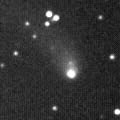
|
It was expected to reach to 9 mag in 2006 spring. But actually, it is much fainer than expected. It brightened up to 13.9 mag on Aug. 1 (Michael Mattiazzo). Then it was expected to brighten rapidly and reach to 11 mag in late September. Although it is not observable in the Northern Hemisphere, it is observable in good condition in the Southern Hemisphere. However, it is actually only 12.4 mag in October (Oct. 2, Michael Mattiazzo). It seems to be a comet with very slow brightness evolution, similar to C/2003 T4. It will be 11 mag at best. After 2006 March, it will be observable in Northern Hemisphere for a long time while it is getting fainter.
Date(TT) R.A. (2000) Decl. Delta r Elong. m1 Best Time(A, h)
Oct. 15 6 12.59 -69 42.7 2.015 2.214 87 11.9 4:38 ( 0,-15)
Oct. 22 6 0.72 -75 55.5 1.991 2.155 85 11.8 3:59 ( 0,-21)
|
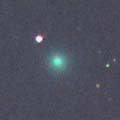
|
New comet discovered by many people in the SWAN images released in late August. It was bright as 9.5 mag visually (Aug. 25, Alan Hale). It has already passed the perihelion on Aug. 9, and it faded rapidly in September. Now it faded down to 12.7 mag (Oct. 11, Reinder J. Bouma). Because it is very diffused, it was reported faint around 15 mag by CCD observations. It will be higher in the morning sky after this, but will be fainter than 13 mag. In the Southern Hemisphere, it must have been visible in good condition in the evening before the discovery, however, it is unobservable after this. It passed near by Owl Nebula and Galaxy M108 in late September. The excellent image by Michael Jager is published.
Date(TT) R.A. (2000) Decl. Delta r Elong. m1 Best Time(A, h)
Oct. 15 10 36.88 67 44.0 1.205 1.446 81 13.0 4:41 (208, 41)
Oct. 22 10 4.56 72 31.9 1.183 1.557 90 13.3 4:47 (199, 45)
|

|
It had been so faint as around 15 mag since May. It had been too faint to see visually. It was also invisible visually, fainter than 13.5 mag on Sept. 3 (Reinder J. Bouma). But an outburst occured on Sept. 9 and brightened to 13 mag (Stephane Garro). However, the outburst already ended, and now it is faint as 14.2 mag (Oct. 1, Maciej Reszelski).
Date(TT) R.A. (2000) Decl. Delta r Elong. m1 Best Time(A, h)
Oct. 15 2 7.47 24 46.3 4.817 5.765 160 13.1 0:34 ( 0, 80)
Oct. 22 2 4.07 24 33.2 4.796 5.766 165 13.1 0:03 ( 0, 80)
|
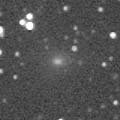
|
It reached to 11.4 mag in August (Aug. 12, Juan Jose Gonzalez). It was expected to start fading since early September. But actually, it keeps bright as 11.8 mag still on Oct. 7 (Juan Jose Gonzalez). Althought it had been very low in the morning for a while, it is getting higher gradually after this. However, it is getting fainter after this, and it will be fainter than 14.5 mag in late November when the altitude becomes higher than 30 degree. In the Southern Hemisphere, it is unobservable until December.
Date(TT) R.A. (2000) Decl. Delta r Elong. m1 Best Time(A, h)
Oct. 15 12 13.99 22 47.0 2.107 1.414 35 13.1 4:41 (251, 13)
Oct. 22 12 26.75 19 41.3 2.158 1.480 36 13.4 4:47 (257, 16)
|

|
It was bright as 7.5 mag in early January, easy to see with binoculars. However, it faded and got diffused rapidly in the evening sky after that. It faded to 10.7 mag on Mar. 15 visually (Alexandre Amorim), and 11.5 mag on Apr. 4 by CCD observation (Mitsunori Tsumura), then it became unobservable. The fading after the perihelion passage is slow. It is visible visually still now, bright as 12.8 mag (Sept. 30, Juan Jose Gonzalez). Because it is distant from the sun, it kept the same brightness since early August when it appeared at dawn. It can be visible visually as 12-13 mag for a while after this.
Date(TT) R.A. (2000) Decl. Delta r Elong. m1 Best Time(A, h)
Oct. 15 3 51.64 -11 10.6 4.035 4.817 137 13.5 2:18 ( 0, 44)
Oct. 22 3 43.60 -11 40.5 4.053 4.886 143 13.6 1:43 ( 0, 43)
|
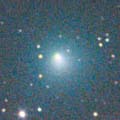
|
It kept bright as 10 mag from May to August, and it was still bright as 10.9 mag on Aug. 5 (Seiichi Yoshida). Then it has been fading, and it faded down to 13.9 mag on Oct. 1 (Mitsunori Tsumura). It is already very low in the evening in the Northern Hemisphere, and few observations have been reported recently. But it keeps observable in the Northern Hemisphere locating very low in the evening until December with an altitude of aroud 17 degree. In the Southern Hemisphere, it keeps locating high until November.
Date(TT) R.A. (2000) Decl. Delta r Elong. m1 Best Time(A, h)
Oct. 15 18 18.62 -32 7.6 1.831 1.803 72 13.7 18:49 ( 27, 17)
Oct. 22 18 39.28 -31 56.1 1.923 1.839 70 14.0 18:41 ( 27, 17)
|

|
In January when it was visible in the Northern Hemisphere, it was an 11 mag small object. However, after it has gone to the southern sky, it brightened rapidly and reached to 8.0 mag from March to April (Mar. 4 and Apr. 7, Alexandre Amorim). After the perihelion passage on Apr. 10, it turned to be fading slowly. But now it became faint as 13.2 mag (Oct. 1, Maciej Reszelski). In the Northern Hesmisphere, it keeps observable in good condition after this while fading gradually. The split of the nucleus was found on June 25. Both nucleus are visible on CCD images still now.
Date(TT) R.A. (2000) Decl. Delta r Elong. m1 Best Time(A, h)
Oct. 15 22 34.68 27 36.6 2.160 2.964 136 13.9 20:57 ( 0, 83)
Oct. 22 22 27.02 26 49.3 2.304 3.047 130 14.2 20:22 ( 0, 82)
|

|
It was fantastic, so bright as 3.5 mag, so large as 30 arcmin, locating high overhead at its best time in early January. Then it has been getting fainter and smaller gradually, 12.5 mag on Sept. 3 (Edwin van Dijk) and 13.6 mag on Sept. 30 (Katsumi Yoshimoto). The diameter is small now, about 2 arcmin, and very diffused. Although it has been observable in the Northern Hemisphere for about one year since its discovery, now it is getting lower and lower. It will be too low in the evening sky soon. But it will appear again in the morning sky at 15 mag in December, then it keeps observable using CCD cameras until next summer.
Date(TT) R.A. (2000) Decl. Delta r Elong. m1 Best Time(A, h)
Oct. 15 15 12.31 6 10.1 4.497 3.684 31 13.9 18:49 ( 88, 13)
Oct. 22 15 19.97 5 13.4 4.602 3.757 28 14.1 18:41 ( 89, 10)
|
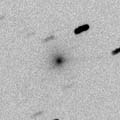
|
It was recorded as an asteroid at the discovery in 2002. It returned again now, and the faint tail was detected and it revealed to be a comet in fact. It passed very close by the earth in August, brightened rapidly from 15 mag to 12 mag. It brightened furthermore in September when appearing in the morning sky again, and reached to 10.3 mag on Sept. 14 (Juan Jose Gonzalez). It was bright as 11.0 mag still on Sept. 25 (Michael Jager). Although it was diffuse in August, now it seems getting strongly condensed. However, now it is fading very rapidly. It faded down to 12.3 mag on Oct. 7 (Juan Jose Gonzalez).
Date(TT) R.A. (2000) Decl. Delta r Elong. m1 Best Time(A, h)
Oct. 15 10 28.73 1 1.6 1.107 0.790 43 14.0 4:41 (285, 22)
Oct. 22 10 46.16 -0 31.3 1.192 0.873 45 15.0 4:47 (289, 24)
|
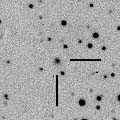
|
It brightened from 18 to 15 mag from the end of 2003 to early 2005. The brightness evolution was much faster than that of a typical comet. Although it had been too low for a while, it is getting higher again now. It was 14.9 mag on Sept. 3 (Ken-ichi Kadota), as bright as expected. It will be already visible visually around 13.5 mag.
Date(TT) R.A. (2000) Decl. Delta r Elong. m1 Best Time(A, h)
Oct. 15 9 28.62 45 14.0 5.540 5.361 74 14.2 4:41 (239, 52)
Oct. 22 9 35.63 45 27.2 5.438 5.348 79 14.1 4:47 (239, 57)
|
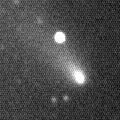
|
Although it became brightest about 2 weeks before the perihelion passage in its last appearance in 1998, it kept brightening until the perihelion passage in this return, and reached to 9.2 mag on July 2 (Carlos Labordena). It faded rapidly after that, 10.4 mag on Aug. 5 (Seiichi Yoshida), 12.7 mag on Sept. 18 (Maciej Reszelski) and 14.2 mag on Oct. 1 (Mitsunori Tsumura). It will be fading while locating around 30 degree high after this in the Northern Hesmisphere.
Date(TT) R.A. (2000) Decl. Delta r Elong. m1 Best Time(A, h)
Oct. 15 8 27.20 -12 38.9 1.735 1.712 71 14.2 4:41 (321, 33)
Oct. 22 8 35.54 -14 46.2 1.741 1.776 75 14.5 4:47 (328, 34)
|
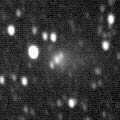
|
It kept bright as 12 mag from June to August, and it was still bright as 12.2 mag on Aug. 2 (Juan Jose Gonzalez), however, it faded down to 13.0 mag on Sept. 8 (Seiichi Yoshida). It faded down to 15.6 mag on Sept. 23 by CCD observations (Mitsunori Tsumura). It had been very low in the Northern Hemisphere. Although it will be higher slowly after this, it is fading.
Date(TT) R.A. (2000) Decl. Delta r Elong. m1 Best Time(A, h)
Oct. 15 19 34.31 -19 18.1 1.412 1.737 90 14.5 18:49 ( 14, 34)
Oct. 22 19 51.47 -18 3.1 1.497 1.766 87 14.8 18:41 ( 15, 36)
|
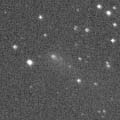
|
New comet. Although it was reported so faint as 16-20 mag, it is actually 14 mag, much brighter than the ephemeris in the public announcement. It is also visible visually as 13.6 mag (Sept. 25, Werner Hasubick). It was reported as 13.0 mag on Oct. 11 (Edwin van Dijk), so it may be brightening gradually. It keeps observable in good condition until winter. It must have been observable as 14-15 mag in 2004 spring and summer, but it was not discovered at that time. Therefore, now it may be in an unusual temporary outburst.
Date(TT) R.A. (2000) Decl. Delta r Elong. m1 Best Time(A, h)
Oct. 15 2 6.30 29 23.6 1.766 2.709 156 14.6 0:33 ( 0, 84)
Oct. 22 1 59.86 29 2.0 1.773 2.735 161 14.6 23:55 ( 0, 84)
|
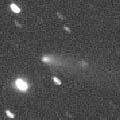
|
It was 16.8 mag at the discovery in May (May 20, R. H. McNaught). Then it brightened rapidly, and reached to 14 mag now (Aug. 2, Michael Jager). It is also visible visually as 13.7 mag (Sept. 3, Edwin van Dijk). Because it moves in the northern sky, it keeps locating high for a long time in the Northern Hemisphere. It will be visible visually at 14 mag until November.
Date(TT) R.A. (2000) Decl. Delta r Elong. m1 Best Time(A, h)
Oct. 15 4 56.65 46 52.6 0.914 1.658 120 14.9 3:23 (180, 78)
Oct. 22 4 58.95 48 44.8 0.907 1.689 125 15.0 2:58 (180, 76)
|

|
In its last appearance in 1984, it unexpectedly brightened after the perihelion passage, and reached to the maximum brightness about 45 days after the perihelion passage. In this return, it was 11.3 mag around the perihelion passage (June 16, Juan Jose Gonzalez), but it continued brightening even after that, and reached to 10.2 mag on July 2 (Juan Jose Gonzalez). However, it turned to fade out 20 days after the perihelion passage in this time. The unexpected brightening in its last appearance seems to be an exceptional outburst. It already faded down to 12.6 mag on Sept. 3 (Reinder J. Bouma). Because it is very diffused, it was reported so faint around 16-17 mag by CCD observations. It will be extremely low between October and November.
Date(TT) R.A. (2000) Decl. Delta r Elong. m1 Best Time(A, h)
Oct. 15 13 57.42 28 13.9 2.680 1.988 37 15.1 18:49 (117, 11)
Oct. 22 14 2.95 26 23.6 2.749 2.053 37 15.4 18:41 (117, 7)
|
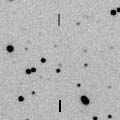
|
Although it was faint as 18 mag at the discovery in 2004 November, then it brightened very rapidly until early 2005, and reached to 16.0 mag on May 7 (Ken-ichi Kadota). It appeared at dawn again now. It was 15.2 mag on Sept. 30 (Ken-ichi Kadota), so it continued brightening as expected. After this, it keeps bright as 15 mag for a long time until 2006 spring. In the Northern Hemisphere, it keeps observable in good condition until 2006 summer when it becomes too faint.
Date(TT) R.A. (2000) Decl. Delta r Elong. m1 Best Time(A, h)
Oct. 15 11 23.25 20 32.6 3.064 2.400 40 15.1 4:41 (260, 22)
Oct. 22 11 37.16 19 31.6 3.021 2.408 44 15.1 4:47 (263, 25)
|

|
Recovery of a peculiar asteroid 2004 FS101 discovered in 2004 spring. Although it was 18 mag in mid January, it has been brightening rather faster than a typical comet, and it reached to 16 mag in early September. It will be 14.5 mag around 2006 January. It keeps observable at 15-16 mag for a long time from 2005 spring to the end of 2006. Because it moves in the northern sky, it keeps observable for a long time in the Northern Hemisphere. However, it will be rather low when the comet becomes brightest. It was not visible visually, fainter than 14.0 mag on Aug. 5 (Seiichi Yoshida), when the altitude was high.
Date(TT) R.A. (2000) Decl. Delta r Elong. m1 Best Time(A, h)
Oct. 15 14 48.62 46 54.8 3.853 3.443 58 15.2 18:49 (129, 28)
Oct. 22 15 2.17 47 7.5 3.797 3.419 60 15.2 18:41 (130, 28)
|
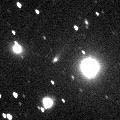
|
Although the CCD nuclear magnitude was reported so faint as 16.5-17 mag, it is actually bright as 15.7 mag (June 26, Giovanni Sostero). Sharply and strongly condensed with a narrow long tail. It will be 15 mag both in 2005 summer and 2006 summer. It moves southwards, so the condition in the Northern Hemisphere is better in 2005. It was visible visually as 13.8 mag when it located high (July 28, Seiichi Yoshida), but no visual observations have been reported recently since it got somewhat lower.
Date(TT) R.A. (2000) Decl. Delta r Elong. m1 Best Time(A, h)
Oct. 15 17 5.01 22 31.8 4.050 3.708 63 15.2 18:49 ( 88, 45)
Oct. 22 17 11.71 20 24.1 4.108 3.703 59 15.3 18:41 ( 87, 41)
|
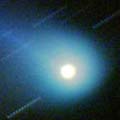
|
The brightness evolution had been slower than a typical comet since its discovery until the perihelion passage in early April. Although it had been observable only until March in the Northern Hemisphere, it has been observed continuously in the Southern Hemisphere, and it kept bright as 8 mag from mid March to mid May. It had been low until early July even in the Southern Hemisphere. The comet had faded out rapidly while locating low. It was 13.0 mag still on Aug. 1 (Michael Mattiazzo). However, it became so faint as 16.0 mag on Oct. 1 when it became observable also in the Northern Hemisphere (Mitsunori Tsumura). It turned to be fading rapidly after the perihelion passage. In the Northern Hemisphere, it keeps very low around 10 degree until the end of 2005.
Date(TT) R.A. (2000) Decl. Delta r Elong. m1 Best Time(A, h)
Oct. 15 7 31.55 -42 21.7 3.036 3.065 82 15.3 4:41 (346, 11)
Oct. 22 7 26.94 -43 23.4 3.057 3.147 85 15.4 4:47 (353, 11)
|
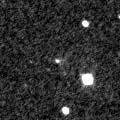
|
It was observed as 17.0 mag on July 10. Then it brightened as expected and reached to 15.0 mag on Oct. 1 (Mitsunori Tsumura). It has shown unstable change of brightness in its past appearance, however, it seems stable in this return. It keeps 15 mag until December. It can be also visible visually as around 14.5 mag.
Date(TT) R.A. (2000) Decl. Delta r Elong. m1 Best Time(A, h)
Oct. 15 0 14.52 -6 15.3 1.476 2.429 158 15.5 22:37 ( 0, 49)
Oct. 22 0 12.17 -6 31.8 1.497 2.415 150 15.5 22:08 ( 0, 48)
|
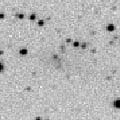
|
It was 13.6 mag on May 12, as bright as expected (Michael Mattiazzo). After that, no successful observations were reported for a while even when the comet became locating high also in the Northern Hemisphere. Actually, it was 17.1 mag on Sept. 3 (Ken-ichi Kadota). It seems the comet faded faster than expected. But it will keep 17 mag for a while.
Date(TT) R.A. (2000) Decl. Delta r Elong. m1 Best Time(A, h)
Oct. 15 5 24.37 9 46.6 1.969 2.611 119 16.2 3:51 ( 0, 65)
Oct. 22 5 22.12 9 30.3 1.932 2.653 126 16.3 3:21 ( 0, 65)
|
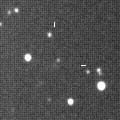
|
First return of a new periodic comet discovered in 1998. The condition is very good and it becomes brighter in this appearance than at the discovery. It was recovered in July at 19.5 mag, as bright as expected. Then it brightened as expected, and reached to 16 mag in September. It will be 16 mag locating high in October and November. But it will be fainter than 18 mag at the end of 2005.
Date(TT) R.A. (2000) Decl. Delta r Elong. m1 Best Time(A, h)
Oct. 15 21 24.90 -14 51.2 0.679 1.441 117 16.2 19:49 ( 0, 40)
Oct. 22 21 31.49 -10 19.5 0.709 1.432 113 16.3 19:28 ( 0, 45)
|

|
It brightened from 19 to 17 mag during a half of a year from summer to winter in 2004. The brightness evolution was rather faster than that of a typical comet. It had been very low for a while, but now it is getting higher again. It was 17.1 mag on Sept. 12 (Yuji Ohshima), as bright as expected. It will be observable in good condition as 16 mag for a long time until next spring.
Date(TT) R.A. (2000) Decl. Delta r Elong. m1 Best Time(A, h)
Oct. 15 9 41.51 53 53.3 5.182 5.058 77 16.4 4:41 (226, 50)
Oct. 22 9 51.32 54 23.3 5.093 5.049 81 16.4 4:47 (224, 53)
|
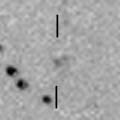
|
New comet. It was 16.8 mag on Sept. 9 (Yuji Ohshima). It keeps observable in good condition as 16.5 mag until November.
Date(TT) R.A. (2000) Decl. Delta r Elong. m1 Best Time(A, h)
Oct. 15 0 30.44 30 46.7 1.101 2.048 154 16.6 22:53 ( 0, 86)
Oct. 22 0 29.52 29 33.7 1.109 2.051 154 16.6 22:25 ( 0, 84)
|
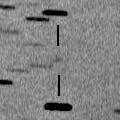
|
It was recovered at 17.3 mag on Sept. 7 (Filip Fratev), as bright as exepcted. It keeps 17.5 mag until December. Although it had been low, it will be higher after this.
Date(TT) R.A. (2000) Decl. Delta r Elong. m1 Best Time(A, h)
Oct. 15 9 32.63 17 35.7 2.009 1.773 61 17.2 4:41 (279, 43)
Oct. 22 9 49.70 17 31.7 1.964 1.788 65 17.3 4:47 (282, 46)
|

|
It reached to 17 mag in 2004 autumn. Now it is getting higher again in the morning sky. It will be observable as 17 mag in good condition in winter again.
Date(TT) R.A. (2000) Decl. Delta r Elong. m1 Best Time(A, h)
Oct. 15 7 39.91 18 37.5 3.009 3.137 88 17.3 4:41 (306, 65)
Oct. 22 7 45.00 18 12.2 2.921 3.146 93 17.3 4:47 (320, 69)
|
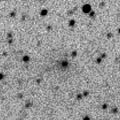
|
It will be at opposition again between autumn and winter, and observable at 17.5 mag locating high.
Date(TT) R.A. (2000) Decl. Delta r Elong. m1 Best Time(A, h)
Oct. 15 4 12.64 18 20.1 3.688 4.469 136 17.4 2:39 ( 0, 73)
Oct. 22 4 9.37 18 16.6 3.630 4.479 144 17.4 2:08 ( 0, 73)
|

|
Fading slowly. It will be fainter than 12 mag. It keeps locating high.
Date(TT) R.A. (2000) Decl. Delta r Elong. m1 Best Time(A, h)
Oct. 15 0 50.38 62 36.8 5.638 6.271 125 17.5 23:13 (180, 62)
Oct. 22 0 41.99 61 47.8 5.674 6.333 127 17.6 22:37 (180, 63)
|
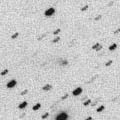
|
It was expected to reach to 13 mag in 2005 spring at the perihelion passage. However, the brightness evolution was very slow actually and it was only 14.5 mag at best. Now it is getting higher again in the morning. Because the current distance is almost same as that at the discovery, it is expected to be as bright as at that time, around 17.5 mag. But if it is fading as a typical comet after the perihelion passage, it can be already fainter than 18 mag.
Date(TT) R.A. (2000) Decl. Delta r Elong. m1 Best Time(A, h)
Oct. 15 8 30.45 4 29.0 3.204 3.071 73 17.7 4:41 (307, 46)
Oct. 22 8 25.54 4 30.0 3.119 3.127 81 17.6 4:47 (318, 52)
|

|
Now it is around the aphelion. However, it will be at opposition in early November and reach to 17.6 mag. It becomes brighter than 18 mag only in November.
Date(TT) R.A. (2000) Decl. Delta r Elong. m1 Best Time(A, h)
Oct. 15 3 41.96 42 19.1 1.571 2.374 133 18.1 2:09 (180, 83)
Oct. 22 3 26.21 42 8.3 1.520 2.385 141 17.9 1:26 (180, 83)
|
|
![]()

 29P/Schwassmann-Wachmann 1
29P/Schwassmann-Wachmann 1 C/2005 N1 ( Juels-Holvorcem )
C/2005 N1 ( Juels-Holvorcem ) C/2003 K4 ( LINEAR )
C/2003 K4 ( LINEAR ) 9P/Tempel 1
9P/Tempel 1 C/2005 A1 ( LINEAR )
C/2005 A1 ( LINEAR ) C/2004 Q2 ( Machholz )
C/2004 Q2 ( Machholz ) 169P/NEAT
169P/NEAT C/2003 WT42 ( LINEAR )
C/2003 WT42 ( LINEAR ) 21P/Giacobini-Zinner
21P/Giacobini-Zinner 37P/Forbes
37P/Forbes P/2005 R2 ( Van Ness )
P/2005 R2 ( Van Ness ) P/2005 K3 ( McNaught )
P/2005 K3 ( McNaught ) 161P/2004 V2 ( Hartley-IRAS )
161P/2004 V2 ( Hartley-IRAS ) P/2004 VR8 ( LONEOS )
P/2004 VR8 ( LONEOS ) C/2005 B1 ( Christensen )
C/2005 B1 ( Christensen ) C/2005 K1 ( Skiff )
C/2005 K1 ( Skiff ) C/2003 T4 ( LINEAR )
C/2003 T4 ( LINEAR ) 101P/Chernykh
101P/Chernykh 10P/Tempel 2
10P/Tempel 2 168P/2005 N2 ( Hergenrother )
168P/2005 N2 ( Hergenrother ) C/2004 D1 ( NEAT )
C/2004 D1 ( NEAT ) P/2005 R1 ( NEAT )
P/2005 R1 ( NEAT ) 171P/2005 R3 ( Spahr )
171P/2005 R3 ( Spahr ) 119P/Parker-Hartley
119P/Parker-Hartley 65P/Gunn
65P/Gunn C/2001 Q4 ( NEAT )
C/2001 Q4 ( NEAT ) C/2004 L1 ( LINEAR )
C/2004 L1 ( LINEAR ) (3200) Phaethon
(3200) Phaethon![]()



























